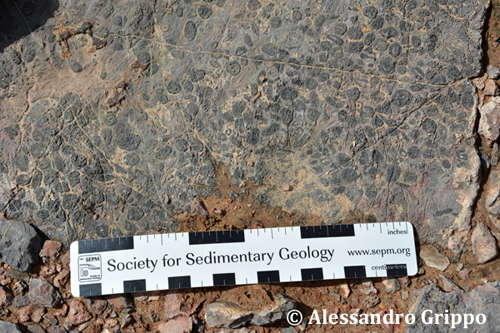 |
GEOL 5 - Earth History (with Lab)
Exam # 3 Study Guide - Spring 2019
exam date: Tuesday, May 28, 2019
Professor: Dr. Alessandro Grippo, Ph.D.
|
|
| |
| General Information | Last Updated • May 19, 2019 | |
PLEASE NOTE:
- You CAN NOT USE cellular phones, iPods, Blackberries, Bluetooth, headphones, computers, pocket calculators, translators or, in general, ANY KIND of electronic device during the test.
All electronic devices MUST BE TURNED OFF: if a cell phone rings, or if a device is on during test time, you will not be allowed to finish your test and your result will be invalidated.
- You can not use any text, notes, dictionary, pocket calculator, flash card, or any other source of information than your brain.
- You will NOT need a ruler or a blue book for this test.
- You will ONLY need to bring:
- one Scantron, Form 882-E
- a number 2 pencil
- an eraser
- This study guide must be interpreted (literally) as a guide to the study of the subject and not as a listing of possible questions.
- On this study guide, there is no additional or extra information compared to what has been said, discussed, shown, illustrated in class.
- It is YOUR personal responsibility to cover the materials listed below on the lecture textbook, on the lab textbook, on "Fossil Ecosystems of North America", on the web pages, and on your notes.
- I would strongly recommend that you peruse your notes for completeness of information: some information that has been detailed in class is only mentioned briefly on the three textbooks, and you are responsible for covering that; know what the key terms and the concepts are (see the list at the end of each chapter on both your textbook and your lab manual); exercise with the questions for review also found at the end of each chapter. Review the materials from your quizzes.
- Read the summary at the end of each chapter, try to answer review questions, try to work with other fellow students if you find it useful.
- Never hesitate to ask me questions in class or during the lab.

Cambrian oncolites from the Chambless Formation, Marble Mountains, California
| |
| Study Guide: part 1 - readings from "Fossil Ecosystems of North America"
| Last Updated • May 19, 2019 | |
There will be a few questions out of Fossil Ecosystems of North America.
Refer to the familiar assignments list for a review.
Only materials from the following chapters will be in this test:
- Gilboa
- Mazon Creek
- The Chinle Group
- The Morrison Formation
- The Hell Creek Formation
You will not be tested on any other chapters. |
| |
| Study Guide: part 2 - LECTURE | Last Updated • May 19, 2019 | |
Chapter 6 - Correlation and Dating of the Rock Record
This paragraph is fully integrated by the web pages and powerpoints on stratigraphy. Be sure to study all parts. Also, do not forget to check the illustrated stratigraphy page.
- Know the Geologic Time Scale
- Know Stratigraphic Units
- Review the Geologic Time Scale
- Review Stratigraphic Units
- Know Earth's Absolute Age
- Know Event Stratigraphy
Some concepts may have been discussed in class only. Refer to your notes. This is one of the most important chapters of the book. Expect detailed questions out of this, and be able to apply the concepts expressed in this section to chapters.
This is the list of powerpoints for this chapter:
Chapter 7 - Evolution and the Fossil Record
This chapter provides you with the foundations for the understanding of Evolution.
You should study the whole chapter and the integrating materials that you can find on the class web page. Here is a detailed summary of the materials you need to know:
- Know the Introduction
- Know Adaptations
- Know Charles Darwin's Contribution (there will be questions on Charles Darwin)
- Read, in order to better understand the ideas behind the chapter, the section "Genes, DNA and Chromosomes" (there will be no direct questions on this short paragraph)
- Read, in order to better understand this chapter, the section "Populations, Species and Speciations". Know what a speciation is.
- Read, in order to better understand this chapter, the section "Rates of Origination". Know what evolutionary radiations and adaptive breakthroughs are.
- Know The Molecular Clock and Times of Origination
- Know Evolutionary Convergence
- Know Extinction
- Know Evolutionary Trends
- Know the online notes on evolution
Review the Structural Geology and Tectonics powerpoint
Know faults and folds (folds are mentioned in Chapter 9 on the textbook but you should have in-depth notes on both faults and folds, including materials on their classification, on strike and dip, on the hanging wall and the foot wall, etc.).
Know about faulting and volcanism (seismic and volcanic activity) along Plate Boundaries
Know about Plate Movements, including measuring the movement, hot spots, thermal plumes, etc.
Chapter 9 - Continental Tectonics and Mountain Chains
Know the whole chapter
- Know about the Rifting of Continents
- Know about Mountain Building, including examples
- Know about Suturing of Small Landmasses to Continents (exotic terranes)
- Know about the Tectonics of Continental Interiors
| -->
| |
| Study Guide: part 3 - LAB | Last Updated • May 19, 2019 | | |
|
|
| |
Copyright © since 1994, Alessandro Grippo, All Rights Reserved.
|


 Go back to the Spring 2019 page
Go back to the Spring 2019 page